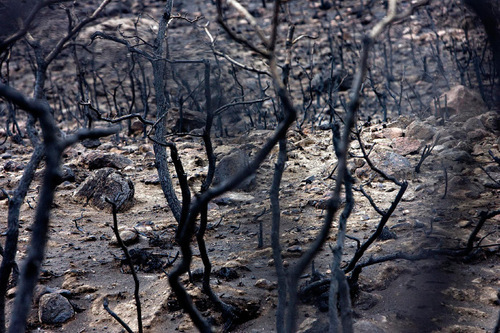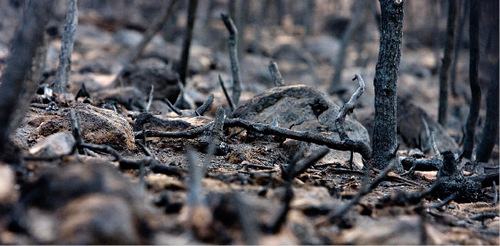This is an archived article that was published on sltrib.com in 2010, and information in the article may be outdated. It is provided only for personal research purposes and may not be reprinted.
The hillsides around Herriman may be burned and blackened now, but they should turn bright green this spring, thanks to volunteers.
The city plans to reseed the hillside Thursday and Friday to help mitigate future flooding and debris flow. So far, more than 500 people have volunteered to help with the project, which involves planting an extensive area by hand.
The city received a $400,000 grant for flood mitigation efforts from the Natural Resources Conservation Service, money that must be used by the end of the month, said city spokeswoman Nicole Martin. Another $40,000 grant paid for the landscape design.
The money will pay for the area to be replanted, as well as other flood prevention measures, such as erosion-preventing mesh. The majority of the 4,300-acre burn scar will be replanted by helicopter, but the highest-risk areas close to homes — about 225 acres — need to be replanted by hand to ensure plants take root and to minimize the risk that invasive plants will encroach on manicured lawns.
The grant money provides relief for the city during tough economic times, when a large-scale disaster was not in the budget, Martin said. Volunteer labor can be used for part of the city's required 25 percent grant match, potentially saving as much as $100,000.
And the volunteer commitments have poured in, filling the 500 needed slots in less than 48 hours, said volunteer coordinator Coralee Moser. At least 16 Boy Scouts are using the event to complete their Eagle Scout projects, and Moser is now in need of only standby volunteers, just in case those who committed can't attend.
Although volunteers are no longer needed for reseeding, Moser expects to need hundreds more before the city has completely recovered from the devastation wrought by the fire.
Burn scars typically need at least five years for a full recovery, said Brian McInerney, a hydrologist with the National Weather Service who studies the effects of fire on flooding in Utah. Although fall isn't known as a growing season, McInerney stressed the importance of getting seed in the ground now.
"I think it's important that you start things growing on the hillside as soon as possible to start the clock running," McInerney said.
Utah's fire areas typically see flooding and debris flow in the second year after a fire, McInerney said, a consequence most recently seen in Draper following the Corner Canyon Fire. Burned areas are unable to absorb water as quickly as those with vegetation, and heavy rainfall can quickly overwhelm the scar. Drops of water begin to bead up, trapping small bits of soil. The beads begin grouping, eventually forming a raging river of concrete-like sludge that will descend the hillside as a debris flow.
Regular rainfall is not a big concern, McInerney stressed, but an inch of water in 30 minutes can pose a risk to anyone with a basement. McInerney urged residents to be vigilant during the next few years, and to leave the area if persistent, heavy rain is pummeling the hillside.
The seeds that will be planted by volunteers are a special blend designed by the U.S. Forest Service, said City Engineer Gordan Haight, and contain a mix for several stages of growth, from quick-growing sterile grasses with roots to secure the hillside, to hardier native grasses and shrubs that will need a few seasons to take hold.
Boy Scouts have already staked the area to indicate where volunteers should scatter seed, ready for youthful volunteers out of school for the Utah Education Association conference. The goal is 60 seeds per square foot, Haight said, but no one will actually be counting. Instead, volunteers will plant "Johnny Appleseed style," spreading handfuls to the wind.
The numbers
500 • Number of volunteers who will help reseed
4,300 • Acres to be replanted by helicopter
225 • Acres to be reseeded by hand







